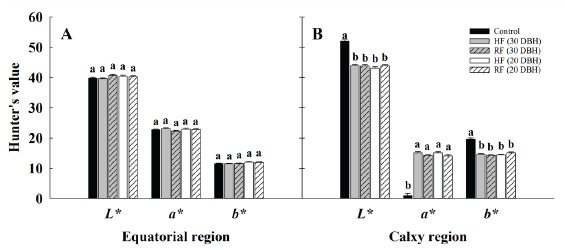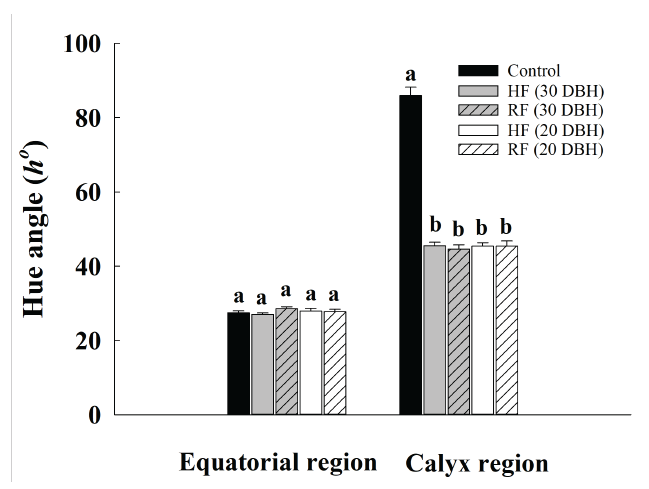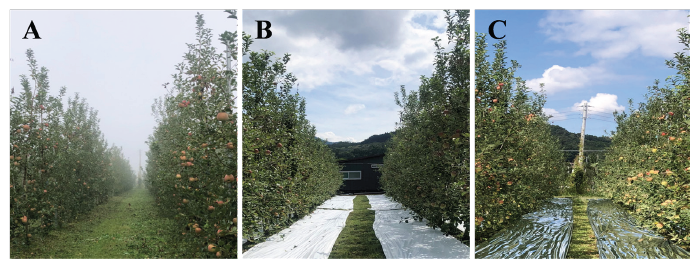Introduction
국내의 사과(Malus domestica Borkh) 가격은 과실 색깔, 크기, 맛, 출하 지역 등 다양한 요인들이 적용되고 있지만, 특히 사과 과실의 과피 착색이 상품성을 결정하는 가장 중요한 요소가 되고 있다(Yim, 2015; Kim et al., 2016). 사과의 과피색 발현은 성숙이 진행되면서 엽록소가 분해되기 시작하여 적색과 황색을 나타내는 안토시아닌과 플라보노이드 색소가 합성되어 착색이 진행되며(Lancaster et al., 1994), 적색은 안토시아닌의 함량에 의하여 결정되며 온도와 햇빛에 영향을 받게 된다(Lancaster and Dougall, 1992; Dong et al., 1995; Lee et al., 2019). 그러나 국내에서는 지구온난화에 의한 기온 상승(Kim et al., 2010)과 성숙기 이상고온 현상 및 밀식장해로 인한 착색이 불량해지는 문제점이 발생하고 있다(Kim et al., 2016; Moon et al., 2022). 이를 해결하기 위하여 사과재배 농가들은 과실돌리기, 적엽(Choi et al., 2000; Nam et al., 2016) 및 수관하부 반사필름 멀칭(Moon et al., 2003; Glenn and Puterka, 2007; Zhang et al., 2015; Lee et al., 2021) 등 작업을 하고 있으나 꽃받침 부위의 착생 향상을 위하여 반사필름을 필수적으로 사용하고 있는 실정이다.
사과의 반사필름처리는 수확예정일 20 - 40일 전에 수관하부에 멀칭하여 과실 꽃받침 부위에 햇빛을 충분히 받게 함으로써 과실 착색을 향상시키고(Shi et al., 2011; Moon et al., 2022), 또한 과실의 당 함량도 증가시키는 효과가 있다(Layne et al., 2001; Aly et al., 2010). 그러나 설치시기와 광량에 따라 과실 하단부에 전달되는 반사광의 일사량이 증가되어 일소과 발생의 피해가 나타나고 있다(RDA, 2016). 현재 사용되고 있는 반사필름은 polyethylene terephthalate (PET) 필름에 알루미늄을 코팅한 은박반사필름으로 전기전도도가 있으며(Taylor and Lewis, 1971), 재활용이 되지 않는 폐기물로 많은 비용이 소요되어 농가 인근에 방치되는 등 주변 경관 훼손 및 환경오염을 발생시키고 있다. 또한 최근에는 경상북도 영덕군에 대형 산불 발생 원인으로 전신주로 날아간 농업용 반사필름에 과전류가 흘러 불꽃이 튀면서 발화된 것으로 추정하는 보도가 나오면서 해당 지역 과수농가와 지자체의 철저한 반사필름 수거 대책이 요구되고 있다(Kyongbukilbo, 2022). 그러므로 최근에 은박반사필름의 문제점을 보완하기 위하여 재활용이 가능하며 부도체로 전기가 통하지 않는 한스펙 반사필름이 개발되었지만 이의 효과는 구명된 바가 없다. 따라서 본 연구는 농업용 한스펙 반사필름 처리가 ‘후지’ 사과의 착색 및 과실품질에 미치는 영향을 구명하고자 하였다.
Materials and Methods
실험재료 및 처리내용
본 실험은 경상북도 군위군(북위 36º10’56.2272’’, 동경 128º34’3.4605’’)에 위치한 농가에서 ‘후지’(8년생/M.9) 사과나무를 대상으로 실시하였다.
실험재료는 무처리, 은박반사필름(Reflective film, 국내시판제품), 한스펙반사필름(HANSPEK film, CaCO3 50% + PE 50%, HANS INTECH Co., Ltd., Daegu, Korea) 등 3처리구를 두었고, 특히 한스펙반사필름은 백색으로 빛이 반사되도록 제작되었다. 반사필름 처리는 수확 30일 전(9월 24일)과 수확 20일 전(10월 4일)에 각각 수관하부에 처리하였고, 반사필름 폭은 양면으로 각각 1,500 mm 제품을 사용하였다(Fig. 1). 과실 수확은 10월 25일에 실시하였고, 병해충 및 기계적 상처과를 제외하고 과실특성을 조사하였다.
수관 광 환경 조사
자연광과 반사광 조도는 조도계(TES-1335, TES electrical electronic Co., Taipei, Taiwan)를 이용하여 반사필름 처리 당일인 9월 24일과 10월 4일, 그리고 수확 당일인 10월 25일 13시에 총 3회 측정하였다. 측정기준은 지면으로부터 50, 100 cm 그리고 150 cm 높이를 기준으로 수체로부터 0 cm 및 30 cm 거리에서 각각 측정하였다(Fig. 2).
과실품질 특성
과중은 전자저울을 이용하여 평균값으로 나타내었다. 과실의 경도는 직경 11 mm plunger를 장착한 Rheometer (Compac-100II, Sun Scientific Co., Tokyo, Japan)를 이용하여 과실 적도부의 과피를 제거한 후에 과실 당 3회 측정한 값을 평균내어 Newton (N)으로 나타내었다. 산 함량(titratable acidity, TA)은 전위차 적정기(DL-15, Mettler Toledo, Greifensee, Switzerland)를 사용하여 과즙 5 mL에 증류수 45 mL를 희석한 후 0.1 N NaOH를 이용하여 pH 8.1로 적정한 후 malic acid로 환산하였다. 가용성 고형물 함량(soluble solids contents, SSC)은 디지털 당도계(PR-201α, Atago Co., Ltd., Tokyo, Japan)를 이용하여 ºBrix로 나타내었다. 과피의 색도는 색차계(CR-400, Konica Minolta Inc., Tokyo, Japan)를 이용하여 적도부위와 꽃받침부위 3지점을 각각 측정하여 L*, a*, b* 그리고 hue angle을 평균값으로 나타내었다.
내생 에틸렌 발생량은 1 mL 주사기를 과실 꽃받침 부위에 삽입하여 과심 내의 gas 1 mL를 채취한 뒤, flame ionization detector를 장착한 gas chromatography (GC 7820A, Agilent Technologies Inc., Santa Clara, CA, USA)를 이용하여 측정하였다. GC 분석 조건은 Porapak Q column (G3591-70014)을 이용하여 injector, oven, detector 온도는 각각 100, 90, 250℃로 설정하였으며, flow rate는 He carrier를 25 mL·min-1로 하였다.
통계분석
과실특성은 5과 1반복으로 하여 3반복, 총 15개의 과실을 대상으로 실시하였으며, 과중과 과피의 착색도는 50과를 1반복으로 하여 3반복, 총 150개의 과실을 대상으로 조사하였다. 모든 데이터는 평균(mean) ± 표준오차(standard error, SE)로 표시하였으며, 통계분석은 SPSS 프로그램(IBM SPSS Statistics 26, IBM Co., Armonk, NY, USA)을 이용하여 필름처리에 따른 과실품질에 대한 평균값의 차이는 유의수준 p < 0.05에서 one-way ANOVA test로 확인하였고 사후검정으로 Duncan’s multiple range test (DMRT)를 실시하였다.
Results and Discussion
반사필름 처리에 따른 위치별 반사광 조도
반사필름 처리에 따른 자연광과 측정 위치별 반사광 조도를 측정한 후에 자연광을 기준으로 백분율로 나타내었다(Table 1). 반사광의 조도 값은 측정위치가 지면으로부터 멀어짐에 따라 감소하는 경향을 보였고, 주간 부위에 비하여 30 cm 떨어진 곳의 조도가 높았다. 특히 무처리구의 반사광의 조도는 3.1 - 5.3 klux로 자연광에 비하여 4.2 - 7.1% 수준이었지만, 은박반사필름(reflective film)과 한스펙필름(HANSPEK film)반사필름 처리구에서는 9.0 - 15.6 klux로 미미한 차이를 보였지만 무처리구에 비하여 반사광의 조도가 1.9 - 3.7배 높아 많은 차이를 보였다. 이는 반사필름 처리구들이 자연광을 반사시키는 효율이 높은 것으로 확인하였지만, 반사필름 종류와 처리시기에 따른 차이는 미미하였다. ‘홍로’ 사과를 대상으로 수확 20일 전에 은박반사필름을 처리하였을 때 무처리구보다 수관하부의 조도값이 증가하였고, 이는 반사필름처리를 통해 지면에 흡수될 빛을 다시 반사시켜 태양에너지 이용효율을 증진시키게 된다(Privé et al., 2008; Moon et al., 2022). 그리고 지면에 가까울수록 반사광의 세기가 크며 멀어질수록 감소되고, 또한 잎이나 가지들에 의하여 차광됨으로써 수광효율도 떨어지기 때문에 위치가 높아짐에 따라 조도 값이 감소한다고 하여(Green et al., 1995; Miller and Greene, 2003; Mika et al., 2007) 동일한 연구결과를 보였다.
과실품질
수확시 과실품질을 보면(Table 2), 모든 처리구들에서 과중, 경도, 가용성 고형물 함량, 산 함량 그리고 내생에틸렌 발생량은 처리시기와 관계없이 과실품질에 차이가 없었다. ‘후지’ 및 ‘갈라’ 사과에서도 수관하부 반사필름 처리에 의해서 광투과를 증대시켜 착색은 향상되지만 과실크기, 과실 경도, 전분 및 당(유리당) 함량의 변화에는 영향을 미치지 않는다고 하였다(Jakopic et al., 2007; Iglesias and Alegre, 2009; Overbeck et al., 2013). 그리고 ‘홍로’ 사과에 하계전정과 함께 반사필름을 처리하였을 때는 착색 향상과 함께 당 함량이 무처리구에 비해 증가하였다고 하였고(Bhusal et al., 2017), 또한 Tahir 등(2005)은 ‘아로마’ 사과에서 반사필름처리가 수확 시 과실품질뿐만 아니라 저온저장시 과실품질까지 유지시켰다고 하였다. 그리고 반사필름 처리에 따른 일소과 발생은 나타나지 않았다(data not shown). 일반적으로 사과의 경우 강한 광선하에서는 과실의 경와부에 일소과 발생이 높고(Seo et al., 2005) 꽃받침 부위는 광에 노출되지 않아 그 발생이 거의 나타나지 않는다. 그러므로 꽃받침 부위의 착색향상을 위하여 반사필름을 처리하면 일사량이 증가되어 일소과 발생의 피해가 나타나고 있다고 하였다(RDA, 2016). 그러나 본 결과에서는 ‘후지’ 사과의 꽃받침 부위에 일소과 피해가 발생하지 않은 것은 반사필름 처리시기가 9월 하순과 10월 상순으로 자연광의 조도가 낮고 또한 반사 조도량은 현저히 낮아(Table 1) 일소과 발생이 없었던 것으로 판단되었다.
따라서 반사필름의 효과는 사과 품종과 재배방법 등에 따라 과실품질에 다소 차이를 보일 수 있다고 추정되어 사과품종별로 적용을 확대해 볼 필요가 있다고 판단되었다.
사과원에 수관하부 반사필름 처리의 목적은 태양광에 노출이 부족한 사과 과실의 꽃받침 부위와 수관 내부에 태양광을 반사시킴으로써 과실의 착색향상을 위하여 이용되고 있다. 그러므로 반사필름 처리에 따른 과피의 착색도를 보면(Fig. 3), 과실의 적도부 착색은 무처리구와 반사필름 처리구 모두에서 차이를 보이지 않았으나(Fig. 3A), 과실의 꽃받침 부위인 과정부는 한스펙필름처리와 은박반사필름처리구의 과실이 무처리 과실에 비하여 L* 및 b*값이 감소되었으며, 특히 적색을 나타내는 a*값은 무처리구는 1.0이었고, 반사필름처리구는 14.1 - 15.1로 현저히 증가되었다(Fig. 3B). 이는 사과에서 착색이 진행됨에 따라 명도(L*)와 황색도(b*)는 낮아지며 안토시아닌이 합성되어 적색도(a*)는 증가하게 된다. 그리고 a*값과 b*값을 기준으로 과피의 색상을 나타내는 hue angle (ho, 색상각)은 0도와 360도에 가까워질수록 적색(red)을 나타내게 된다. 따라서 a*값과 b*값을 기준으로 보면 ho값은 무처리 과실은 85.9였으나, 반사필름 처리 과실들은 44.6 - 45.5로 적색 색상이 현저히 향상되었고 처리 30일 전과 20일 전 처리구에서는 차이를 보이지 않았다(Fig. 4). ‘홍로’와 ‘갈라’ 사과에서도 반사필름 처리를 통해 a*값이 증가되고, 관련하여 ho이 감소되어 과피 착색이 향상된다고 보고하였다(Iglesias and Alegre, 2009; Bhusal et al., 2017). 사과 과실의 착색향상은 광, 온도 등 다양한 환경 요인에 의해 조절되며(Iglesias et al., 2002; Ubi, 2004), 특히 광은 사과 과피색 발현에 있어서 주요 조절인자로 작용한다(Lancaster and Dougall, 1992). 또한 충분한 태양광의 에너지와 적절한 스펙트럼을 조성하는 빛은 안토시아닌 합성을 개시하는 데 필수적으로 알려져 있다(Lancaster and Dougall, 1992; Ubi, 2004). 따라서 보통 빛이 잘 들지 않는 수관 하부의 경우 과피색 발현에 있어서 제한적이므로 반사필름 처리를 통해서 수관하부의 반사광 세기 및 광투과율을 증가시켜 과실의 과정부 착색을 향상시키며 수체의 전반적인 광투과율을 증대시켜 과실의 착색을 증진시키게 되어(Blanke, 2008; Iglesias and Alegre, 2009) 한스펙필름처리가 과실의 착색 향상을 촉진시키는 효과를 보였다.

Fig. 3. Effect of film treatments on hunter’s value (L* , a* and b* ) of ‘Fuji’ apples at harvest. Data are presented as mean ± SE (n = 150). a, b: Different letters indicated statistically significant differences at p<< 0.05 based on Duncan’s multiple range test. DBH, days before harvest; HF, HANSPEK film; RF, reflective film.

Fig. 4. Effect of film treatments on hue angle (hº ) of ‘Fuji’ apples at harvest. Data are presented as mean ± SE (n = 150). a, b: Different letters indicated statistically significant differences at p < 0.05 based on Duncan’s multiple range test. DBH, days before harvest; HF, HANSPEK film; RF, reflective film.
Conclusion
본 연구는 농업용 은박반사필름과 한스펙반사필름처리에 따른 ‘후지’ 사과의 착색 및 과실품질에 미치는 영향을 구명하고자 하였다. 연구결과를 종합해 보면, 은박반사필름과 한스펙 반사필름은 ‘후지’ 사과나무의 수관하부 반사광 조도량에 차이를 보이지 않았고, 이를 통하여 과실 과정부의 광투과 효율성이 향상되어 과피 착색이 향상되는 결과를 보였다. 따라서 PE필름에 탄산칼슘이 코팅된 한스펙 반사필름은 재활용이 가능하며 부도체로서 화재의 위험도 예방할 수 있다는 관점에서 현장적용이 가능하다고 판단되었다.








